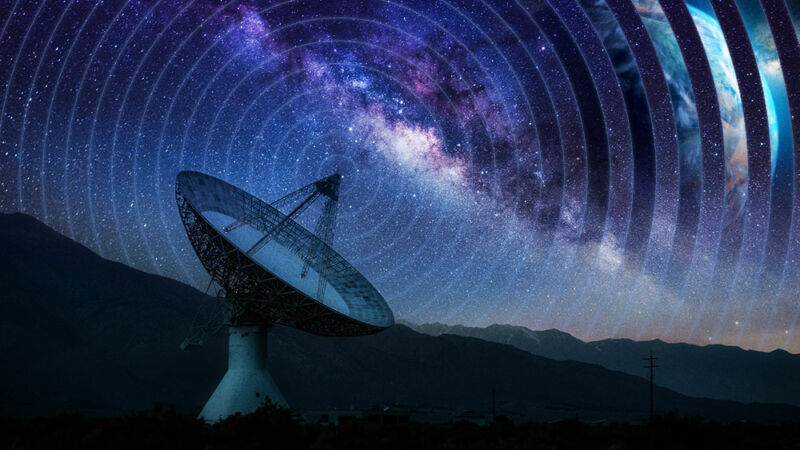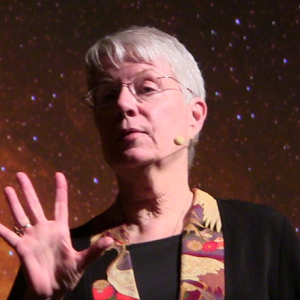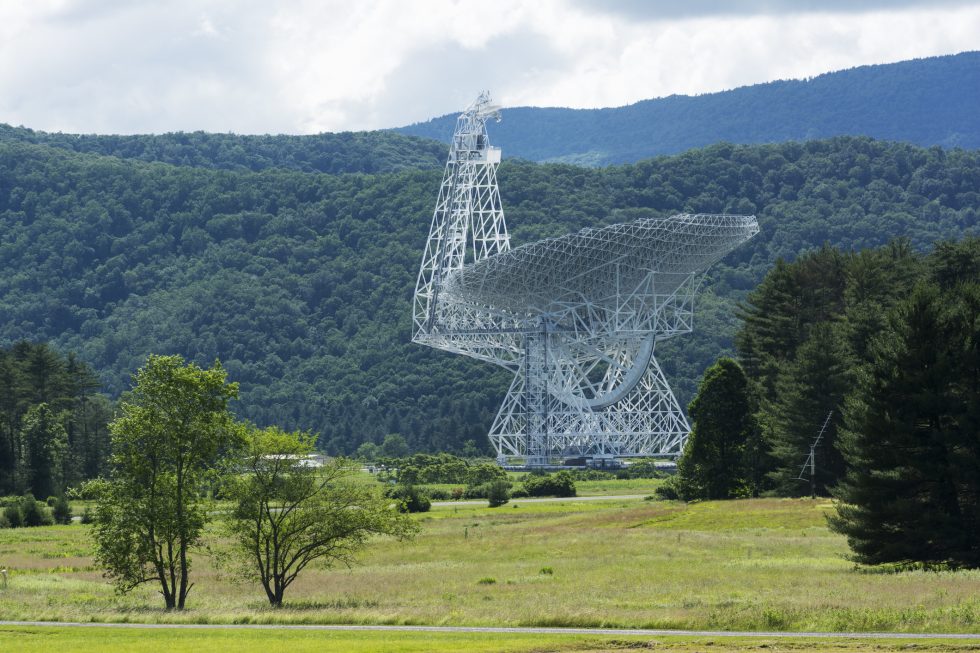
In 1993, a team of scientists published a paper in the scientific journal Nature that announced the detection of a planet harboring life. Using instruments on the spacecraft Galileo, they imaged the planet’s surface and saw continents with colors “compatible with mineral soils” and agriculture, large expanses of ocean with “spectacular reflection,” and frozen water at the poles. An analysis of the planet’s chemistry revealed an atmosphere with oxygen and methane so abundant that they must come from biological sources. “Galileo found such profound departures from equilibrium that the presence of life seems the most probable cause,” the authors wrote.
But the most telltale sign of life was measured by Galileo’s spectrogram: radio transmissions from the planet’s surface. “Of all Galileo science measurements, these signals provide the only indication of intelligent, technological life,” wrote the authors.
The paper’s first author was Carl Sagan, the astronomer, author, and science communicator. The planet that he and his co-authors described was Earth.
Twenty years later, as far as we can tell, Earth remains the only planet in the Universe with any life, intelligent or otherwise. But that Galileo fly-by of Earth was a case study for future work. It confirmed that modern instruments can give us hints about the presence of life on other planets—including intelligent life. And since then, we’ve dedicated decades of funding and enthusiasm to look for life elsewhere in the Universe.
But one component of this quest has, for the most part, been overlooked: the Search for Extraterrestrial Intelligence (SETI). This is the field of astronomical research that looks for alien civilizations by searching for indicators of technology called “technosignatures.” Despite strong support from Sagan himself (he even made SETI the focus of his 1985 science-fiction novel Contact, which was turned into a hit movie in 1997 starring Jodie Foster and Matthew McConaughey), funding and support for SETI have been paltry compared to the search for extraterrestrial life in general.
Throughout SETI’s 60-year history, a stalwart group of astronomers has managed to keep the search alive. Today, this cohort is stronger than ever, though they are mostly ignored by the research community, largely unfunded by NASA, and dismissed by some astronomers as a campy fringe pursuit. After decades of interest and funding dedicated toward the search for biological life, there are tentative signs that SETI is making a resurgence.
At a time when we’re in the process of building hardware that should be capable of finding signatures of life (intelligent or otherwise) in the atmospheres of other planets, SETI astronomers simply want a seat at the table. The stakes are nothing less than the question of our place in the Universe.

How to search for life on other worlds
You may have heard of searching for life on other planets by looking for “biosignatures”—molecules or phenomena that would only occur or persist if life were present. These could be microbes discovered by directly sampling material from the planet (known as “in-situ sampling”) or using spectroscopic biosignatures, like chemical disequilibria in the atmosphere and images of water and agriculture, like those detected by the Galileo probe in 1990.
The biosignature search is happening now, but it comes with limitations. In-situ sampling requires sending a spacecraft to another planet; we’ve done this, for example, with rovers sent to Mars and the Cassini spacecraft that sampled plumes of water erupting from Saturn’s moon Enceladus. And while in-situ sampling is the ideal option for planets in the Solar System, with our current technology, it will take millennia to get a vehicle to a planet orbiting a different star—and these exoplanets are far, far more numerous.
To detect spectroscopic biosignatures we will need telescopes like the James Webb Space Telescope (JWST) or the ground-based Extremely Large Telescope, both currently under construction. To directly image an exoplanet and obtain more definitive spectra will require future missions like LUVOIR (Large Ultraviolet Optical Infrared Surveyor) or the Habitable Exoplanet Imaging Mission. But all of these lie a number of years in the future.
SETI researchers, however, are interested in “technosignatures”—biosignatures that indicate intelligent life. They are signals that could only come from technology, including TV and radio transmitters—like the radio transmission detected by the Galileo spacecraft—planetary radar systems, or high-power lasers.
The first earnest call to search for technosignatures—and SETI’s formal beginning—came in 1959. That was the year that Cornell University physicists Giuseppe Cocconi and Philip Morrison published a landmark paper in Nature outlining the most likely characteristics of alien communication. It would make the most sense, they postulated, for aliens to communicate across interstellar distances using electromagnetic waves since they are the only media known to travel fast enough to conceivably reach us across vast distances of space. Within the electromagnetic spectrum, Cocconi and Morrison determined that it would be most promising to look for radio waves because they are less likely to be absorbed by planetary atmospheres and require less energy to transmit. Specifically, they proposed a narrowband signal around the frequency at which hydrogen atoms emit radiation—a frequency that should be familiar to any civilization with advanced radio technology.
What’s special about these signals is that they exhibit high degrees of coherence, meaning there is a large amount of electromagnetic energy in just one frequency or a very small instance of time—not something nature typically does.
“As far as we know, these kinds of [radio] signals would be unmistakable indicators of technology,” says Andrew Siemion, professor of astronomy at the University of California, Berkeley. “We don’t know of any natural source that produces them.”
Such a signal was detected on August 18, 1977 by the Ohio State University Radio Observatory, known as “Big Ear.” Astronomy professor Jerry Ehman was analyzing Big Ear data in the form of printouts that, to the untrained eye, looked like someone had simply smashed the number row of a typewriter with a preference for lower digits. Numbers and letters in the Big Ear data indicated, essentially, the intensity of the electromagnetic signal picked up by the telescope, starting at 1 and moving up to letters in the double-digits (A was 10, B was 11, and so on). Most of the page was covered in 1s and 2s, with a stray 6 or 7 sprinkled in.
But that day, Ehman found an anomaly: 6EQUJ5. This signal had started out at an intensity of 6—already an outlier on the page—climbed to E, then Q, peaked at U—the highest power signal Big Ear had ever seen—then decreased again. Ehman circled the sequence in red pen and wrote “Wow!” next to it.
Alas, SETI researchers have never been able to detect the so-called “Wow! Signal” again, despite many tries with radio telescopes around the world. To this day, no one knows the source of the Wow! Signal, and it remains one of the strongest candidates for alien transmission ever detected.
NASA began funding SETI studies in 1975, a time when the idea of extraterrestrial life was still unthinkable, according to former NASA Chief Historian Steven J. Dick. After all, no one then knew if there were even other planets outside our Solar System, much less life.

In 1992, NASA made its strongest-ever commitment to SETI, pledging $100 million over ten years to fund the High Resolution Microwave Survey (HRMS), an expansive SETI project led by astrophysicist Jill Tarter. One of today’s most prominent SETI researchers, Tarter was the inspiration for the protagonist of Sagan’s Contact, Eleanor Arroway.
But less than a year after HRMS got underway, Congress abruptly canceled the project. “The Great Martian Chase may finally come to an end,” said Senator Richard Bryan of Nevada, one of its most vocal detractors. “As of today, millions have been spent and we have yet to bag a single little green fellow. Not a single Martian has said take me to your leader, and not a single flying saucer has applied for FAA approval.”
The whole ordeal was “incredibly traumatic,” says Tarter. “It [the removal of funding] was so vindictive that, in fact, we became the four-letter S-word that you couldn’t say at NASA headquarters for decades.”
Since that humiliating public reprimand by Congress, NASA’s astrobiology division has been largely focused on searching for biosignatures. And it has made sure to distinguish its current work from SETI, going so far as to say in a 2015 report that “the traditional Search for Extraterrestrial Intelligence… is not a part of astrobiology.”
Despite or because of this, the SETI community quickly regrouped and headed to the private sector for funding. Out of those efforts came Project Phoenix, rising from the ashes of the HRMS. From February 1995 to March 2004, Phoenix scanned about 800 nearby candidate stars for microwave transmission in three separate campaigns with the Parkes Observatory in New South Wales, Australia; the National Radio Astronomy Observatory in Green Bank, West Virginia; and Arecibo Observatory in Puerto Rico. The project did not find any signs of E.T., but it was considered the most comprehensive and sensitive SETI program ever conducted.
At the same time, other projects run by the Planetary Society and UC Berkeley (including a project called SERENDIP, which is still active) carried out SETI experiments and found a handful of anomalous radio signals, but none showed up a second time.
To search or not to search
There is plenty of understandable skepticism surrounding the search for extraterrestrial intelligence. At first glance, one might reason that biosignatures are more common than technosignatures and therefore easier to detect. After all, complex life takes a long time to develop and so is probably rarer. But as astronomer and SETI researcher Jason Wright points out, “Slimes and fungus and molds and things are extremely hard to detect [on an exoplanet]. They’re not doing anything to get your attention. They’re not commanding energy resources that might be obvious at interstellar distances.”
Linda Billings, a communications consultant for NASA’s Astrobiology Division, is not so convinced that SETI is worth it. She worked with SETI in the early 1990s when it was still being funded by the space agency.
“I felt like there was a resistance to providing a realistic depiction of the SETI search, of how limited it is, how little of our own galaxy that we are capable of detecting in radio signals,” Billings says.
While she supports NASA’s biosignature searches, she feels that there are too many assumptions embedded into the idea that intelligent aliens would emit signals that we can intercept and understand, so the likelihood of successfully detecting technosignatures is too low.
What is the likelihood of encountering extraterrestrial intelligence? Astronomers have thought about this question and have even tried to quantify it, most famously in the Drake equation, introduced by radio astronomer Frank Drake in 1961. The equation estimates the number of active and communicative alien civilizations in the Milky Way galaxy by considering seven factors:
R* = The rate of formation of stars suitable for the development of intelligent life.
fp = The fraction of those stars with planetary systems.
ne = The number of planets, per solar system, with an environment suitable for life.
fl = The fraction of suitable planets on which life actually appears.
fi = The fraction of life-bearing planets on which intelligent life emerges.
fc = The fraction of civilizations that develop a technology that releases detectable signs of their existence into space.
L = The length of time such civilizations release detectable signals into space.
Since these values have been largely conjectural, the Drake equation has served as more of a thought exercise than a precise calculation of probability. But SETI skeptics reason that the equation’s huge uncertainties render the search futile until we know more.
Plus, the question remains as to whether we are looking the “right” way. By assuming aliens will transmit radio waves, SETI researchers also assume that alien civilizations must have intelligence similar to humans’. But intelligence—like life—could develop elsewhere in ways we can’t possibly imagine. So for some, the small chance that aliens are sending out radio transmissions isn’t enough to justify the search.
Seth Shostak, senior astronomer at the SETI Institute, defended the radio approach in a blog post honoring Frank Drake’s 90th birthday earlier this year. “…[A] search for radio transmissions is not a parochial enterprise,” he wrote. “It doesn’t assume that the aliens are like us in any particular, only that they live in the same Universe, with the same physics.”
SETI researchers can also cast a much wider net with their radio searches: Optical telescopes looking for biosignatures can only resolve data from exoplanets within a few tens of light-years, totaling to no more than 100 tractable targets. But existing radio observatories, like those at Green Bank and in Arecibo, can detect signals as far as 10,000 light-years away, producing 10-million more targets than biosignature search methods.
The SETI community has no desire to stop the search for biosignatures. “Technosignatures and biosignatures both lie under the same umbrella that we call ‘astrobiology,’ so we are trying to learn from each other,” says Tarter.

The current state of SETI
Since the 1990s, new discoveries have strengthened the case to search for technosignatures. For example, NASA’s Kepler Space Telescope has identified over 4,000 exoplanets, and Kepler data suggest that half of all stars may harbor Earth-sized exoplanets, many of which may be the right distance from their stars to be conducive to life. Plus, the discovery of extremophiles—organisms that can grow and thrive in extreme temperature, acidity, or pressure—has shown astrobiologists that life exists in environments previously assumed to be inhospitable.
But of the two arms of the search for life, SETI is still up against a perception problem—what some call a “giggle factor.” What does it take for SETI to be taken seriously? There are some indications that the perception problem is solving itself, albeit slowly.
In 2015, SETI got a much-needed injection of cash—and faith—when Russian-born billionaire Yuri Milner pledged $100 million over 10 years to form the Breakthrough Initiatives, including Breakthrough Listen, a SETI project based at UC Berkeley and directed by Andrew Siemion. As the name suggests, Breakthrough Listen’s goal is to listen for signs of intelligent life. Breakthrough Listen has access to more than a dozen facilities around the world, including the NRAO in Green Bank, the Arecibo Observatory, and the MeerKAT radio telescope in South Africa.
A few years later in 2018, NASA—prodded by SETI fan and Texas Congressman Lamar Smith—hosted a technosignatures workshop at the Lunar and Planetary Institute in Houston, Texas. Over the course of three days, SETI scientists including Wright and Siemion met and discussed the current state of technosignature searches and how NASA could contribute to the field’s future. But Smith retired from Congress that same year, which put SETI’s future with federal funding back into question.
In March 2019, Pennsylvania State University announced the new Penn State Extraterrestrial Intelligence Center (PSETI)—to be led by Wright, who is an associate professor of astronomy and astrophysics at the school. One of just two astrobiology PhD programs in the world (the other is at UCLA), PSETI plans on hosting the first Penn State SETI Symposium in June 2021.
Some of PSETI’s main goals are to permanently fund SETI research worldwide, train the next generation of SETI practitioners, and support and foster a worldwide SETI community. These elements are important to any scientific endeavor but are currently lacking in the small field, even with initiatives like Breakthrough Listen. According to a recent white paper, only five people in the US have ever earned a PhD with SETI as the focus of their dissertations, and that number won’t be growing rapidly any time soon.
“If you can’t propose for grants to work on a topic, it’s really difficult to convince young graduate students and postdocs to work in the field, because they don’t really see a future in it,” says Siemion.
Tarter agrees that community and funding are the essential ingredients to SETI’s future. “We sort of lost a generation of scientists and engineers in this fallow period where a few of us could manage to keep this going,” she says. “A really well-educated, larger population of young exploratory scientists—and a stable path to allow them to pursue this large question into the future—is what we need.”

Wright often calls SETI low-hanging fruit. “This field has been starved of resources for so long that there is still a ton of work to do that could have been done decades ago,” says Wright. “We can very quickly make a lot of progress in this field without a lot of effort.” This is made clear in Wright’s SETI graduate course at Penn State, in which his students’ final projects have sometimes become papers that get published in peer-reviewed journals—something that rarely happens in any other field of astronomy.
In February 2020, Penn State graduate student Sofia Sheikh submitted a paper to The Astrophysical Journal outlining a survey of 20 stars in the “restricted Earth Transit Zone,” the area of the sky in which an observer on another planet could see Earth pass in front of the sun. Sheikh didn’t find any technosignatures in the direction of those 20 stars, but her paper is one of a number of events in the past year that seem to signal the resurgence of SETI.
In July 2019, Breakthrough Listen announced a collaboration with VERITAS, an array of gamma-ray telescopes in Arizona. VERITAS agreed to spend 30 hours per year looking at Breakthrough Listen’s targets for signs of extraterrestrial intelligence starting in 2021. Breakthrough Listen also announced, in March 2020, that it will soon partner with the NRAO to use the Very Large Array (VLA), an array of radio telescopes in Socorro, New Mexico. (Coincidentally, the VLA was featured in the film Contact but was never actually used in SETI research.)
And there are other forthcoming projects that take advantage of alternate avenues to search. Optical SETI instruments, like PANOSETI, will look for bright pulses in optical or near-infrared light that could be artificial in origin. Similarly, LaserSETI will use inexpensive, wide-field, astronomical grade cameras to probe the whole sky, all the time, for brief flickers of laser light coming from deep space. However, neither PANOSETI nor LaserSETI are fully funded.
Just last month, though, NASA did award a grant to a group of scientists to search for technosignatures. It is the first time NASA has given funding to a non-radio technosignature search, and it’s also the first grant to support work at PSETI. The project team, led by Adam Frank from the University of Rochester, includes Jason Wright.
“It’s a great sign that the winds are changing at NASA,” Wright said in an email. He credits NASA’s 2018 technosignatures workshop as a catalyst that led NASA to relax its stance against SETI research. “We have multiple proposals in to NASA right now to do more SETI work across its science portfolio and I’m more optimistic now that it will be fairly judged against the rest of the proposals.”
Despite all the obstacles in their path, today’s SETI researchers have no plans to stop searching. After all, they are trying to answer one of the most profound and captivating questions in the entire Universe: are we alone?
“You can certainly get a little tired and a little beat down by the challenges associated with any kind of job. We’re certainly not immune from that in SETI or in astronomy,” admits Siemion. “But you need only take 30 seconds to just contemplate the fact that you’re potentially on the cusp of making really an incredibly profound discovery—a discovery that would forever change the human view of our place in the universe. And, you know, it gets you out of bed.”
"behind" - Google News
July 25, 2020 at 08:00PM
https://ift.tt/330oOzU
The real science behind SETI’s hunt for intelligent aliens - Ars Technica
"behind" - Google News
https://ift.tt/2YqUhZP
https://ift.tt/2yko4c8
Bagikan Berita Ini














0 Response to "The real science behind SETI’s hunt for intelligent aliens - Ars Technica"
Post a Comment